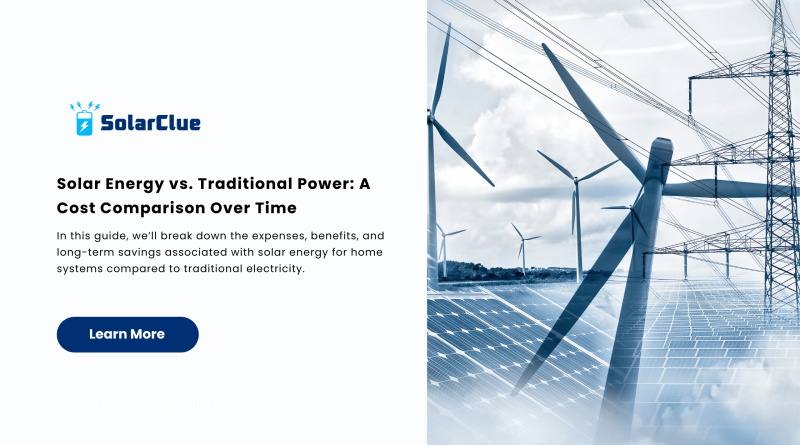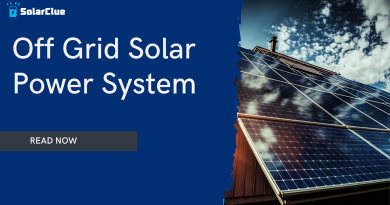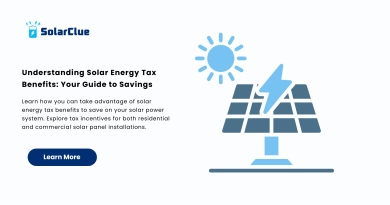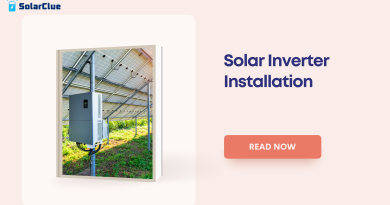Solar Energy vs. Traditional Power: A Cost Comparison Over Time
The global shift toward sustainability has fueled discussions around solar power for home use versus traditional power sources. As more households explore solar panels for house installations, understanding the cost differences over time is essential. In this guide, we’ll break down the expenses, benefits, and long-term savings associated with solar energy for home systems compared to traditional electricity.
Table of Contents
- 1 The Basics: Solar Energy vs. Traditional Power
- 2 Initial Installation Costs
- 3 Monthly Energy Bills: Solar vs. Traditional Power
- 4 Maintenance and Longevity
- 5 Environmental Impact
- 6 Return on Investment (ROI)
- 7 Energy Independence and Resilience
- 8 Government Incentives for Solar
- 9 Solar Panels for Your Home: Popular Options
- 10 Common Misconceptions About Solar
- 11 Conclusion: Is Solar Energy Worth It?
- 12 FAQs
The Basics: Solar Energy vs. Traditional Power
1. What Is Solar Energy?
Solar energy harnesses sunlight through solar panels for your home, converting it into electricity. This solar electricity for home use is clean, renewable, and environmentally friendly.
2. Traditional Power Explained
Traditional power relies on fossil fuels like coal, natural gas, and oil. While widely accessible, these energy sources emit greenhouse gases and contribute to climate change.
3. Why Compare Costs?
As more households consider solar for home installations, understanding the return on investment (ROI) compared to traditional power costs helps make informed decisions.
Initial Installation Costs
1. Solar System for Home Price
The upfront cost of a home solar system can range from $10,000 to $30,000, depending on system size and energy needs. However, government incentives and tax credits can reduce these expenses significantly.
2. Traditional Power Setup
Traditional electricity systems typically have lower initial costs since most homes are pre-wired for grid power. However, homeowners may face additional expenses for infrastructure upgrades or increased energy demand.
Monthly Energy Bills: Solar vs. Traditional Power
1. Solar Energy for Home
Once installed, solar panels for house drastically reduce or even eliminate monthly electricity bills. Households with battery storage can achieve near-total energy independence.
2. Traditional Power Costs
Energy bills for traditional power are subject to fluctuating fuel prices, seasonal surcharges, and rate hikes. On average, U.S. households spend $120 to $150 monthly on electricity.
Maintenance and Longevity
1. Maintaining Solar Products for Home
Solar systems require minimal maintenance. Panels typically last 25-30 years, with warranties covering most issues. Occasional cleaning and inverter replacements may be needed.
2. Traditional Power Infrastructure
While homeowners don’t directly maintain grid infrastructure, outages, electrical repairs, and rising utility rates can be costly over time.
Environmental Impact
1. Solar Energy: A Sustainable Choice
Switching to solar power for house use reduces carbon emissions and reliance on fossil fuels. Solar is a renewable resource, meaning it will never run out.
2. Traditional Energy’s Environmental Cost
Fossil fuel-based power contributes significantly to pollution and global warming. As demand grows, the environmental strain intensifies.
Return on Investment (ROI)
1. Solar Systems ROI
Although solar system for home price may seem high initially, savings on energy bills and tax incentives provide an attractive ROI within 5-10 years.
2. Traditional Power ROI
Traditional power lacks long-term savings potential. Continued reliance on grid electricity results in ongoing costs without significant financial returns.
Energy Independence and Resilience
1. Benefits of Solar Power for Home
By generating solar electricity for home, you can protect your household from blackouts and price surges. Battery storage solutions add another layer of energy security.
2. Traditional Power Limitations
Homes relying solely on the grid face vulnerability during outages, natural disasters, and supply chain disruptions.
Government Incentives for Solar
Federal and state programs offer tax credits, rebates, and grants to make home solar system cost more affordable. These incentives can reduce installation expenses by up to 30%.
Solar Panels for Your Home: Popular Options
1. Monocrystalline Panels:
High efficiency and long lifespan.
2. Polycrystalline Panels:
Cost-effective but slightly less efficient.
3. Thin-Film Panels:
Lightweight and flexible, ideal for unique installations.
Common Misconceptions About Solar
1. Myth 1: Solar Only Works in Sunny Climates
Truth: Solar products for home use can generate electricity even on cloudy days, thanks to advancements in technology.
2. Myth 2: Solar Panels Are Too Expensive
Truth: With declining prices and incentives, solar for home systems are more affordable than ever.
3. Myth 3: Maintenance Is Complicated
Truth: Modern solar systems require little upkeep, making them convenient for homeowners.
Conclusion: Is Solar Energy Worth It?
When comparing solar energy to traditional power, solar panels for house installations offer significant long-term savings, energy independence, and environmental benefits. While the solar system for home price may be a hurdle initially, incentives and reduced energy bills make it a smart investment.
FAQs
1. How much does a home solar system cost?
The average solar system for home price ranges from $10,000 to $30,000 before incentives.
2. Can solar panels power my entire house?
Yes! With the right system size and battery storage, solar panels for your home can meet all your energy needs.
3. How long do solar panels last?
Most solar products for home use last 25-30 years with minimal maintenance.
4. Are there government incentives for installing solar?
Yes, federal and state programs offer tax credits and rebates to reduce home solar system cost.
5. Is solar energy environmentally friendly?
Absolutely. Solar energy is a clean, renewable resource that reduces carbon emissions and dependency on fossil fuels.
That’s all for today! For more information, visit our website.




